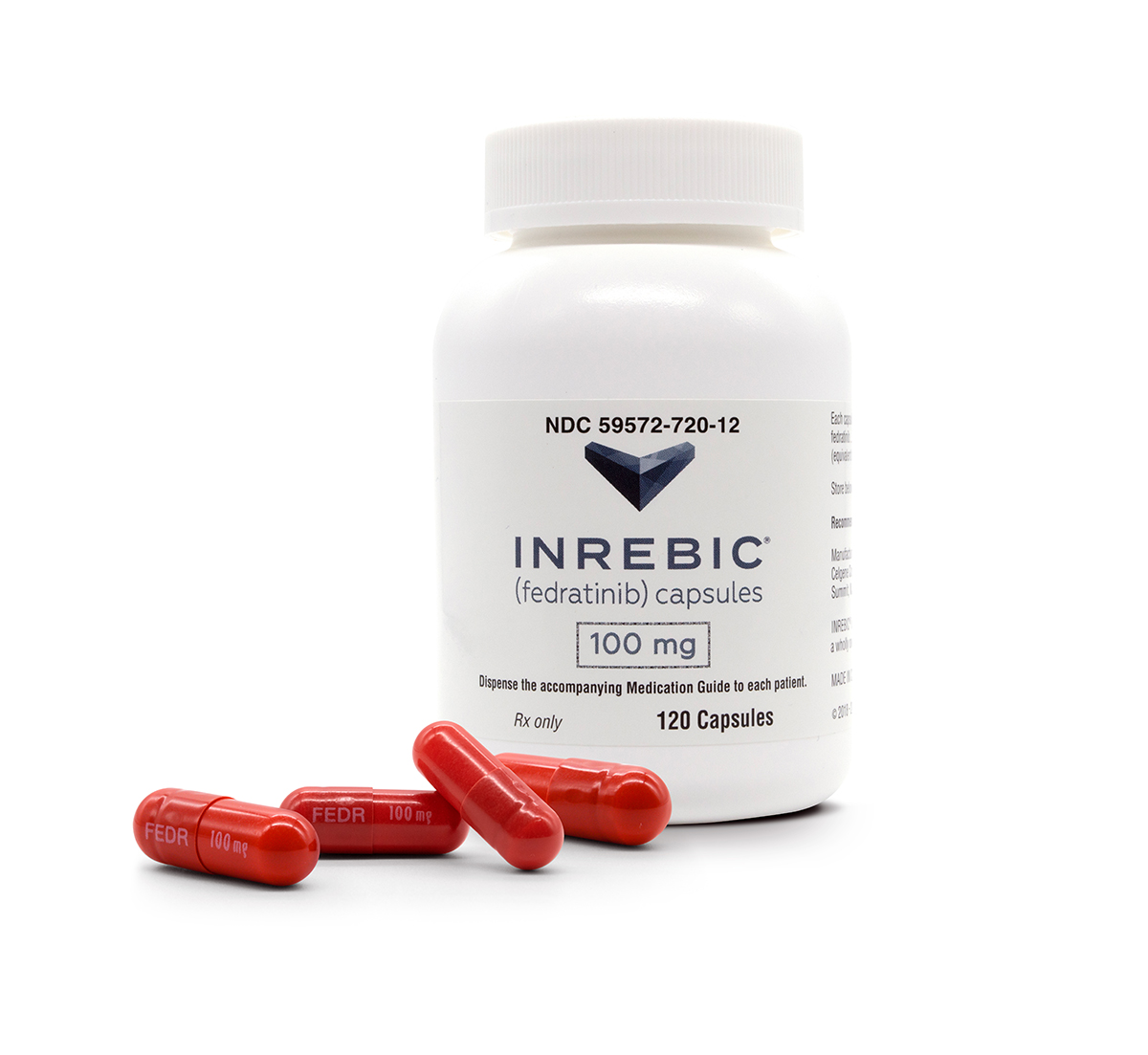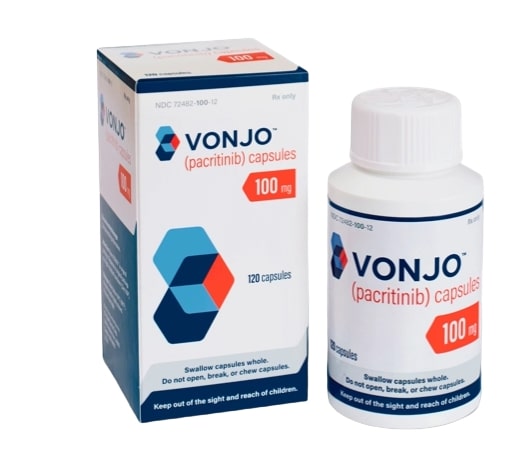New Myelofibrosis treatments 2024
New Myelofibrosis Treatments 2024
Myelofibrosis is a rare type of chronic leukemia—a cancer that affects the bone marrow, which is where the body produces blood cells. In myelofibrosis, the marrow is replaced by fibrous (scar) tissue, which leads to a severe decrease in blood cell production. This condition can result in anemia, weakness, fatigue, and an enlarged spleen and liver. Symptoms also often include bone pain, bruising, and an increased risk for infections due to the lack of healthy white blood cells. Myelofibrosis can occur on its own (primary myelofibrosis) or as a progression of other bone marrow diseases (secondary myelofibrosis).
When considering treatment options for myelofibrosis, it is crucial to consult with a healthcare professional who specializes in blood disorders, such as a hematologist. Treatment strategies may vary depending on the severity of the disease and the patient's overall health. Medications like ruxolitinib and fedratinib are FDA-approved to treat certain patients with myelofibrosis and can help reduce spleen size and alleviate symptoms. In some cases, a stem cell transplant may be recommended as a potential cure for younger patients with a suitable donor. Other treatments include blood transfusions, androgens, immunomodulatory drugs, and the use of corticosteroids to manage anemia and other symptoms associated with the disease.

Treatment options
| Treatment option | Estimated cost | Efficacy | Eligibility |
|---|---|---|---|
| Ruxolitinib (Jakafi) | $10,000 - $12,000 | Reduces spleen size and symptoms | Intermediate or high-risk myelofibrosis |
| Fedratinib (Inrebic) | $11,000 - $13,000 | Reduces spleen size and symptoms | Adults with intermediate-2 or high-risk primary or secondary myelofibrosis |
| Pacritinib | $8,000 - $10,000 | Reduces spleen size, not yet FDA approved | Adults with myelofibrosis and thrombocytopenia |
| Luspatercept | $7,000 - $9,000 | Improves anemia, not yet FDA approved for myelofibrosis | Myelofibrosis patients with anemia |
| Evaluation of Parsaclisib plus Ruxolitinib | Not available | Potential to improve outcomes in ruxolitinib-resistant patients, experimental | Patients with myelofibrosis who have not responded to Ruxolitinib alone |
| Pomalidomide | $9,500 - $11,500 | May improve anemia, off-label use | Myelofibrosis patients with anemia |
| Imetelstat | Not available | Shows promise in early clinical trials, not yet FDA approved | Myelofibrosis patients, often in clinical trials |
| Stem Cell Transplant | $100,000 - $300,000 | Potentially curative but with high risk | Selected patients with high-risk myelofibrosis |
| Pacritinib (Vonjo) | $8,000 - $10,000 | Reduces spleen size and symptoms, FDA approval pending | Myelofibrosis patients with severe thrombocytopenia |
| Hydroxyurea | $50 - $100 | May control blood counts, less effective for symptoms or spleen size | Myelofibrosis patients with high blood cell counts |
| Interferon Alfa | $1,000 - $5,000 | May improve blood counts, off-label use | Myelofibrosis patients with high blood cell counts |
| Thalidomide | $3,000 - $5,000 | May improve symptoms, off-label use | Myelofibrosis patients with symptoms or anemia |
| Androgen Therapy (Danazol) | $200 - $400 | May improve anemia, off-label use | Myelofibrosis patients with anemia |
Treatments options in detail
Pharmacological Treatment Options for Myelofibrosis
Myelofibrosis is a chronic myeloproliferative neoplasm characterized by bone marrow fibrosis, splenomegaly, and a range of systemic symptoms. The treatment landscape for myelofibrosis is primarily focused on alleviating symptoms, reducing spleen size, and improving overall quality of life. The cornerstone of pharmacological treatment for myelofibrosis is JAK inhibitors, with ruxolitinib being the first FDA-approved medication for this indication.
Ruxolitinib is a JAK1 and JAK2 inhibitor that has been shown to reduce spleen volume and alleviate symptoms associated with myelofibrosis. It is indicated for patients with intermediate or high-risk myelofibrosis, including primary myelofibrosis, post-polycythemia vera myelofibrosis, and post-essential thrombocythemia myelofibrosis. The dosage of ruxolitinib is typically titrated based on efficacy and tolerability, with close monitoring of blood counts due to the risk of cytopenias.
Following ruxolitinib, fedratinib is another JAK2 inhibitor approved by the FDA for the treatment of adults with intermediate or high-risk primary or secondary myelofibrosis. Fedratinib can be used in patients who have been previously treated with ruxolitinib or as a first-line treatment. It is important to monitor patients for thiamine levels before and during treatment with fedratinib due to the risk of Wernicke's encephalopathy.
Additional Pharmacological Agents for Myelofibrosis
In addition to JAK inhibitors, other treatments may be considered based on the patient's individual disease characteristics and response to initial therapies. Danazol, a synthetic androgen, may be used to treat anemia associated with myelofibrosis, although its use is off-label for this indication. Immunosuppressive therapy, such as corticosteroids or thalidomide, with or without prednisone, may also be used in certain cases to manage anemia.
Hydroxyurea is often employed for patients with significant leukocytosis or thrombocytosis and is considered a cytoreductive therapy. However, its efficacy in reducing spleen size or improving symptoms is limited compared to JAK inhibitors.
Allogeneic stem cell transplantation remains the only curative treatment for myelofibrosis but is associated with significant morbidity and mortality. It is typically reserved for younger patients with high-risk disease and those who have a suitable donor.
Emerging Treatments and Clinical Trials
Several new treatments for myelofibrosis are currently under investigation, including novel JAK inhibitors and combination therapies. Inrebic (fedratinib) is one of the newer JAK inhibitors that has been approved by the FDA for patients with intermediate-2 or high-risk primary or secondary myelofibrosis, including those who have been previously treated with ruxolitinib.
Experimental treatments, such as the evaluation of parsaclisib plus ruxolitinib, are being studied in patients with myelofibrosis who have not responded to ruxolitinib alone. Parsaclisib is a PI3Kδ inhibitor, and the combination with ruxolitinib aims to target different pathways involved in the pathogenesis of myelofibrosis. Clinical trials are ongoing to determine the efficacy and safety of this combination.
Vonjo (pacritinib) is another JAK2 inhibitor that has shown promise in clinical trials, particularly for patients with severe thrombocytopenia. It is currently under review by the FDA and is not yet approved. Pacritinib may offer an option for patients who are intolerant to or have an inadequate response to other JAK inhibitors.
Other experimental therapies include BET inhibitors, telomerase inhibitors, and hedgehog pathway inhibitors. These agents are being evaluated in clinical trials and offer potential new avenues for treatment, although they have not yet received FDA approval for myelofibrosis.
Supportive Care and Off-Label Treatments
Supportive care is a critical component of myelofibrosis management and includes transfusions for anemia, treatment of infections, and the use of growth factors such as erythropoietin or G-CSF in select cases. Iron chelation therapy may be considered for patients with transfusion-dependent anemia to prevent iron overload.
Off-label use of medications is common in myelofibrosis, particularly for symptom management. This includes the use of erythropoiesis-stimulating agents for anemia and the use of analgesics for pain management. Interferon-alpha has been used off-label in some patients with myelofibrosis, particularly those with a significant polycythemic component or those who are pregnant.
Conclusion
Myelofibrosis treatment is tailored to the individual patient based on disease severity, symptoms, and response to prior treatments. JAK inhibitors, particularly ruxolitinib and fedratinib, are the mainstay of pharmacological therapy. Emerging treatments and combination therapies are under investigation and may expand the therapeutic options for patients with myelofibrosis in the future. Supportive care and off-label drug use remain important aspects of managing this complex disease.
Symptoms
Splenomegaly (Enlarged Spleen)
One of the most common symptoms of myelofibrosis is an enlarged spleen, known medically as splenomegaly. This occurs because the spleen tries to take over the blood cell-making function from the fibrotic bone marrow. Patients may experience discomfort or pain in the left upper quadrant of the abdomen, a feeling of fullness without eating, or an early satiety due to the pressure of the enlarged spleen on the stomach.
Anemia
Anemia, a condition characterized by a decrease in the number of red blood cells, is a prevalent symptom in myelofibrosis. Patients with anemia may feel fatigued, weak, or short of breath, particularly upon exertion. They may also exhibit pallor or a pale complexion due to the reduced oxygen-carrying capacity of their blood.
Thrombocytopenia or Thrombocytosis
Abnormal platelet counts are common in myelofibrosis. Some patients may have thrombocytopenia, which is a low platelet count, leading to an increased risk of bleeding and bruising. Conversely, others may have thrombocytosis, which is an elevated platelet count, potentially increasing the risk of blood clots (thrombosis).
Leukoerythroblastosis
Leukoerythroblastosis is a blood picture that shows immature white blood cells (leukocytes) and red blood cells (erythrocytes) circulating in the blood, which is indicative of myelofibrosis. This symptom reflects the extramedullary hematopoiesis, where blood cell production occurs outside the bone marrow, such as in the spleen or liver.
Constitutional Symptoms
Patients with myelofibrosis often experience constitutional symptoms, which are systemic and affect the entire body. These include fever, weight loss, and excessive sweating, particularly at night (night sweats). These symptoms are a result of the body's inflammatory response to the disease process.
Bone Pain
Bone pain is a frequent symptom in myelofibrosis and can be particularly severe. It typically affects the hips and legs and is due to the expansion of the bone marrow cavity or the proliferation of abnormal bone marrow cells.
Portal Hypertension
As the spleen enlarges, it can impede the flow of blood through the portal vein, which can lead to increased blood pressure in this vessel, known as portal hypertension. This can cause complications such as varices, which are enlarged veins that can bleed, and ascites, which is the accumulation of fluid in the abdominal cavity.
Extramedullary Hematopoiesis
When the bone marrow is unable to produce blood cells effectively, this function may be taken up by other organs, such as the spleen or liver, in a process called extramedullary hematopoiesis. This can lead to the enlargement of these organs and related symptoms, including abdominal discomfort and fullness.
Pruritus (Itching)
Some patients with myelofibrosis develop pruritus, which is severe itching of the skin. This symptom can be particularly bothersome and is believed to be related to the release of histamines or other chemicals from the abnormal proliferation of mast cells in the skin.
Gout and Hyperuricemia
Increased cell turnover in myelofibrosis can lead to elevated levels of uric acid in the blood, known as hyperuricemia. This can cause gout, a form of arthritis characterized by sudden, severe attacks of pain, redness, and tenderness in joints, often the joint at the base of the big toe.
Respiratory Symptoms
Respiratory symptoms may occur in myelofibrosis due to anemia or enlargement of the spleen or liver, which can impede the movement of the diaphragm and cause shortness of breath, particularly with exertion or when lying down. In advanced stages, extramedullary hematopoiesis in the lungs can lead to pulmonary hypertension and additional respiratory complications.
Neurologic Symptoms
Although less common, neurologic symptoms can occur in myelofibrosis. These may include headaches, dizziness, and visual disturbances, which can result from anemia, thrombocytopenia, or, rarely, the development of blood clots in the cerebral vessels.
Cardiovascular Symptoms
Cardiovascular symptoms such as palpitations, chest pain, and edema, particularly in the lower extremities, can be present in myelofibrosis. These symptoms often arise from anemia or the increased workload on the heart due to the elevated blood volume associated with splenomegaly.
Infection Susceptibility
Myelofibrosis can lead to a compromised immune system, making patients more susceptible to infections. This is due to both the reduced number of normal white blood cells that can fight infection and the potential for spleen dysfunction, which plays a role in filtering bacteria from the blood.
Abdominal Vein Thrombosis
Patients with myelofibrosis are at an increased risk of developing blood clots in the abdominal veins, such as the portal, splenic, or mesenteric veins. This can lead to abdominal pain, fever, and in severe cases, can cause life-threatening complications.
Transformation to Acute Leukemia
A small percentage of patients with myelofibrosis may experience transformation to acute myeloid leukemia (AML). This is a serious and more aggressive condition characterized by the rapid growth of abnormal white blood cells that accumulate in the bone marrow and interfere with the production of normal blood cells.
Cure
Current Therapeutic Approaches for Myelofibrosis
Myelofibrosis, a type of chronic leukemia, is a disorder of the bone marrow that disrupts the body's normal production of blood cells. As of the current medical understanding and treatments available, there is no definitive cure for myelofibrosis outside of stem cell transplantation. However, treatment can help relieve symptoms and improve quality of life for those affected by the disease.
Stem Cell Transplantation
The closest option to a cure for myelofibrosis is allogeneic hematopoietic stem cell transplantation (HSCT), which involves replacing the diseased bone marrow with healthy marrow from a donor. This procedure has the potential to be curative, but it carries significant risks, including graft-versus-host disease, infection, and organ damage. It is typically reserved for younger patients and those with a suitable donor, as well as for patients with high-risk disease characteristics.
Pharmacological Management
Although not curative, several medications can manage symptoms and complications of myelofibrosis. JAK inhibitors, such as ruxolitinib, are the cornerstone of pharmacological therapy. They target the Janus kinase (JAK) pathways, which are often dysregulated in myelofibrosis, and can reduce spleen size and alleviate symptoms. However, JAK inhibitors do not reverse the fibrosis of the bone marrow or significantly alter the natural course of the disease.
Other Medications and Off-Label Use
Other treatments may include androgens, immunomodulators, and cytotoxic chemotherapy, although these are generally less effective than JAK inhibitors and are considered on a case-by-case basis. Off-label use of drugs in myelofibrosis is common, as physicians may try different combinations of therapies to manage symptoms and improve blood counts. Clinical trials are also a source of potential off-label treatments, offering patients access to experimental therapies that may benefit their condition.
Supportive Care
Supportive care is a critical component of managing myelofibrosis, focusing on relieving symptoms and improving the patient’s quality of life. This includes blood transfusions for anemia, platelet transfusions for thrombocytopenia, and treatments to manage pain, fatigue, and other symptoms. Iron chelation therapy may be used to treat iron overload, which can occur due to frequent blood transfusions.
Emerging Therapies and Research
Research into new treatments for myelofibrosis is ongoing, with several promising avenues being explored. These include novel JAK inhibitors, telomerase inhibitors, and therapies targeting other pathways implicated in the disease. Gene therapy and targeted molecular therapies are areas of intense investigation that may offer hope for more effective treatments in the future.
Considerations for Treatment Selection
The choice of treatment for myelofibrosis depends on various factors, including the patient's age, overall health, symptoms, and disease severity. The risk-benefit profile of potential treatments is carefully considered, as some therapies may offer symptom relief but come with a higher risk of side effects. A multidisciplinary team approach is often employed to tailor the treatment plan to the individual needs of the patient.
Conclusion on Cure Potential
In conclusion, while there is no universal cure for myelofibrosis, stem cell transplantation offers the potential for a cure in select patients. For the majority of patients, treatment focuses on symptom management, quality of life improvement, and slowing disease progression. Advances in research continue to bring new insights and potential treatments that may one day offer a cure or more effective management for this complex disease.
Access Myelofibrosis medicines today
If Myelofibrosis medicines are not approved or available in your country (e.g. due to supply issues), you can access them via Everyone.org.
How Everyone.org works

Make an enquiry
Choose the medicine you want to access, answer a couple of questions, and upload your prescription to speed things up. We’ll get back to you within 24 hours.


Make an enquiry
Choose the medicine you want to access, answer a couple of questions, and upload your prescription to speed things up. We’ll get back to you within 24 hours.


Breeze through the paperwork
We'll guide you through the required documents for importing unapproved medicine, ensuring you have all the necessary information.


Get a personalized quote
We’ll prepare a quote for you, including medicine costs and any shipping, administrative, or import fees that may apply.


Receive your medicine
Accept the quote and we’ll handle the rest - sourcing and safely delivering your medicine.

Some text on this page has been automatically generated. Speak to your physician before you start a new treatment or medication.
Let's talk
If you have any questions, call us or send us a message through WhatsApp or email:
Contact us




